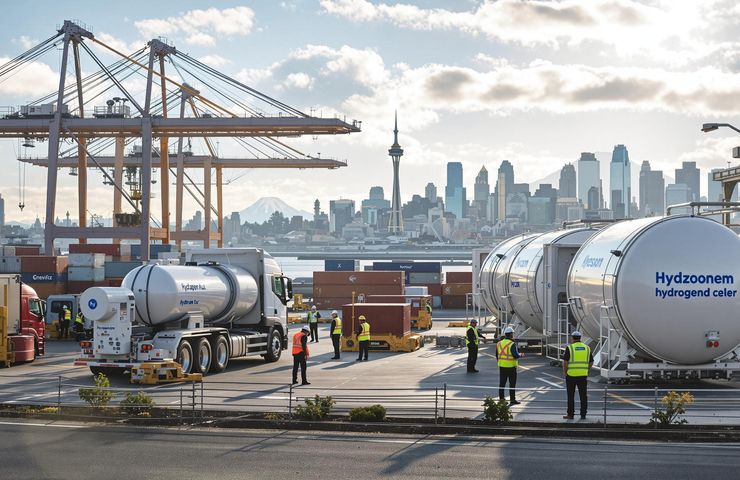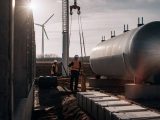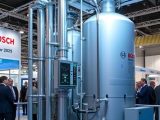
Green Hydrogen Puts Seattle on the Map as a Future Clean Energy Leader
July 29, 2025Seattle—the city where maritime grit meets tech ingenuity—is stepping boldly into the spotlight as one of the U.S.’s most promising contenders in the push to clean up heavy industry. And it’s no coincidence. Under the banner of the Pacific Northwest Hydrogen Hub (PNWH2), the Port of Seattle has teamed up with key partners like the Port of Tacoma, Northwest Seaport Alliance, Seattle City Light, Pacific Northwest National Laboratory (PNNL), and the U.S. Department of Energy (DOE)—all working together to bring green hydrogen into the mainstream.
Why Green Hydrogen Is a Big Deal
Sure, electrification is making waves—but it’s not the fix-all for everything, especially in ports, aviation, and freight. These sectors burn through fuel in ways that batteries just can’t handle efficiently. That’s where green hydrogen comes in. With the energy punch of a gallon of gas packed into just one kilogram—and only water vapor as the byproduct—it’s a clean, powerful alternative for the jobs electricity struggles with.
Enter the DOE’s Hydrogen Shot, a major push to make green hydrogen affordable—just $1 per kilogram. With abundant hydroelectric resources and a deep-rooted clean energy culture, the Pacific Northwest is in a prime position to hit that mark.
Seattle’s Game Plan Under PNWH2
The Port of Seattle and its partners are digging into the details, mapping out how green hydrogen could overhaul port logistics. Think hydrogen-powered cranes, yard tractors, even backup power systems during outages. While no facilities are running just yet, blueprints are being drawn, and progress is moving fast—especially when it comes to the infrastructure and safety planning spearheaded by PNNL and Seattle City Light.
This all hinges on Seattle’s unique position. With nearly 770,000 residents and one of the highest rent-per-capita averages in the country, the area blends dense urban life with heavy industrial activity. Building clean energy infrastructure here isn’t just about powering ports—it’s about proving that sustainable industry and urban living can actually thrive together.
Meet the Team Making It Happen
The backbone of PNWH2 is the Pacific Northwest Hydrogen Association, a coalition pulling the strings behind the scenes—uniting public and private interests, bringing in federal dollars, and laying down the policy framework needed to push things forward. Seattle City Light is digging into how hydrogen could reinforce the power grid, especially during emergencies or peak loads. Meanwhile, the Northwest Seaport Alliance is working on incentive programs to get hydrogen-fueled trucks and cargo gear onto the docks.
What’s critical here is the big-picture approach. They’re not just popping up one-off projects—they’re creating a full-on hydrogen ecosystem. From renewable-powered hydrogen production and storage to fuel cells built for industrial-scale use, it’s all being mapped out scientifically and strategically, in line with federal climate targets.
Why It Matters for Everyone
This isn’t just about testing a new fuel. It’s part of a movement with serious benefits:
- Cleaner air around neighborhoods that border ports and industrial areas
- Lower emissions that help Washington meet its climate action goals
- More reliable energy—especially in extreme weather or during grid outages
- Local job growth in fields like engineering, construction, and clean tech
In a region that already leads in sustainability, this feels like the next logical step. And it’s one that could catapult the Pacific Northwest into the national spotlight—joining big players like California, Texas, and New York in shaping the U.S. hydrogen economy.
What’s Still in the Way?
Let’s be real—no transition this big is without roadblocks. Costs are still high. Infrastructure? Still taking shape. And when it comes to policy, consistency is a must if this thing is going to scale. Community engagement will also be crucial—especially for folks living near planned hydrogen storage and refueling sites. Trust and transparency have to be front and center.
And while federal backing has been strong so far, there’s always a risk of changing political winds. If clean energy credits dry up or policy shifts, the pace could slow and budgets could swell. That’s why the ongoing commitment of the DOE and state-level leaders is absolutely critical to keeping this momentum alive.
A Peek at What’s Coming
Right now, Seattle doesn’t have a fleet of hydrogen-powered trucks rolling through its ports or fuel flowing out of a dedicated H2 station. But give it time. The planning is real. The science checks out. The partners are committed. If things keep moving in this direction, it won’t be long before green hydrogen is just another part of life here—fueling logistics, stabilizing the grid, and cleaning up one of the country’s most active port regions.
This isn’t just a project—it’s a shift in how ports, cities, and energy systems interact. Cleaner ships. Smarter cargo movement. Air you can breathe. Energy you can count on. That’s the vision, and from what we can see? Seattle’s well on its way.
Curious to learn more? Check out the latest updates at Port of Seattle – Green Hydrogen and Pacific Northwest Hydrogen Association.



 With over 15 years of reporting hydrogen news, we are your premier source for the latest updates and insights in hydrogen and renewable energy.
With over 15 years of reporting hydrogen news, we are your premier source for the latest updates and insights in hydrogen and renewable energy.